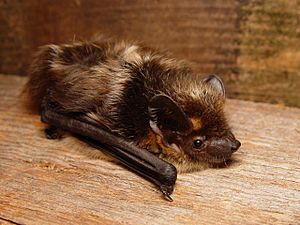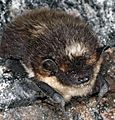Northern bat facts for kids
Quick facts for kids Northern bat |
|
|---|---|
 |
|
| A northern bat, crawling on a wooden surface | |
| Conservation status | |
| Scientific classification | |
| Genus: |
Eptesicus
|
| Species: |
nilssonii
|
 |
|
The northern bat (Eptesicus nilssonii) is a fascinating species of bat found across a wide area in Eurasia. It's a close relative of the serotine bat (Eptesicus serotinus). These bats are known for being able to live in colder places than many other bat species. They are small, quick flyers that help keep insect populations in check.
Contents
What is a Northern Bat?
Northern bats are small to medium-sized bats. They usually weigh between 8 and 18 grams. Their bodies are about 4 to 6 centimeters long. They have a wingspan of about 24 to 28 centimeters.
Appearance and Features
These bats have dark brown fur on their backs. Their bellies are a bit lighter. They have short, rounded ears. Their faces are often dark, almost black. Their wings are also dark.
Where Northern Bats Live
Northern bats live in many different places. You can find them across northern and eastern Europe. They also live throughout Asia. This includes countries like Russia, China, and Japan. They are one of the most widespread bat species.
Habitat and Environment
These bats like to live in forests. They also live near mountains and in urban areas. They often roost in buildings, tree hollows, or rock crevices. They can adapt to many different environments. This helps them live in so many places.
What Northern Bats Eat
Northern bats are insectivores. This means they eat insects. They are very good at catching flying insects in the dark. They use a special skill called echolocation.
How They Hunt
Echolocation helps them find food. They send out high-pitched sounds. These sounds bounce off objects. The bats listen for the echoes. This tells them where insects are. They can even tell how big the insect is. They catch insects like moths and beetles. They also eat mosquitoes and flies.
Life and Behavior
Northern bats are nocturnal. This means they are active at night. They sleep during the day. They often roost in groups. These groups can be small or quite large.
Hibernation
In colder regions, northern bats hibernate. They find safe, cool places to sleep through winter. This helps them save energy. They can hibernate in caves or old mines. Sometimes they use cellars or attics.
Reproduction and Life Cycle
Northern bats usually mate in late summer or autumn. The female stores the male's sperm. She doesn't become pregnant right away. She waits until spring. This is called delayed fertilization.
Raising Young Bats
In early summer, females give birth. They usually have one baby, called a pup. The pups are born without fur. They cannot see or fly. The mother bat cares for her pup. She feeds it milk. Pups grow very quickly. They learn to fly after a few weeks. They become independent soon after.
Conservation Status
The northern bat is listed as "Least Concern" by the IUCN. This means they are not currently endangered. Their populations are stable in most areas. However, like all bats, they face some threats.
Threats to Bats
Habitat loss is a threat. This happens when forests are cut down. Pesticides can also harm them. These chemicals reduce their food supply. They can also get sick from them. Protecting their roosting sites is important.
Images for kids
-
Northern bat hibernating deep in a disused cobalt mine in Norway
See also
 In Spanish: Murciélago norteño para niños
In Spanish: Murciélago norteño para niños



